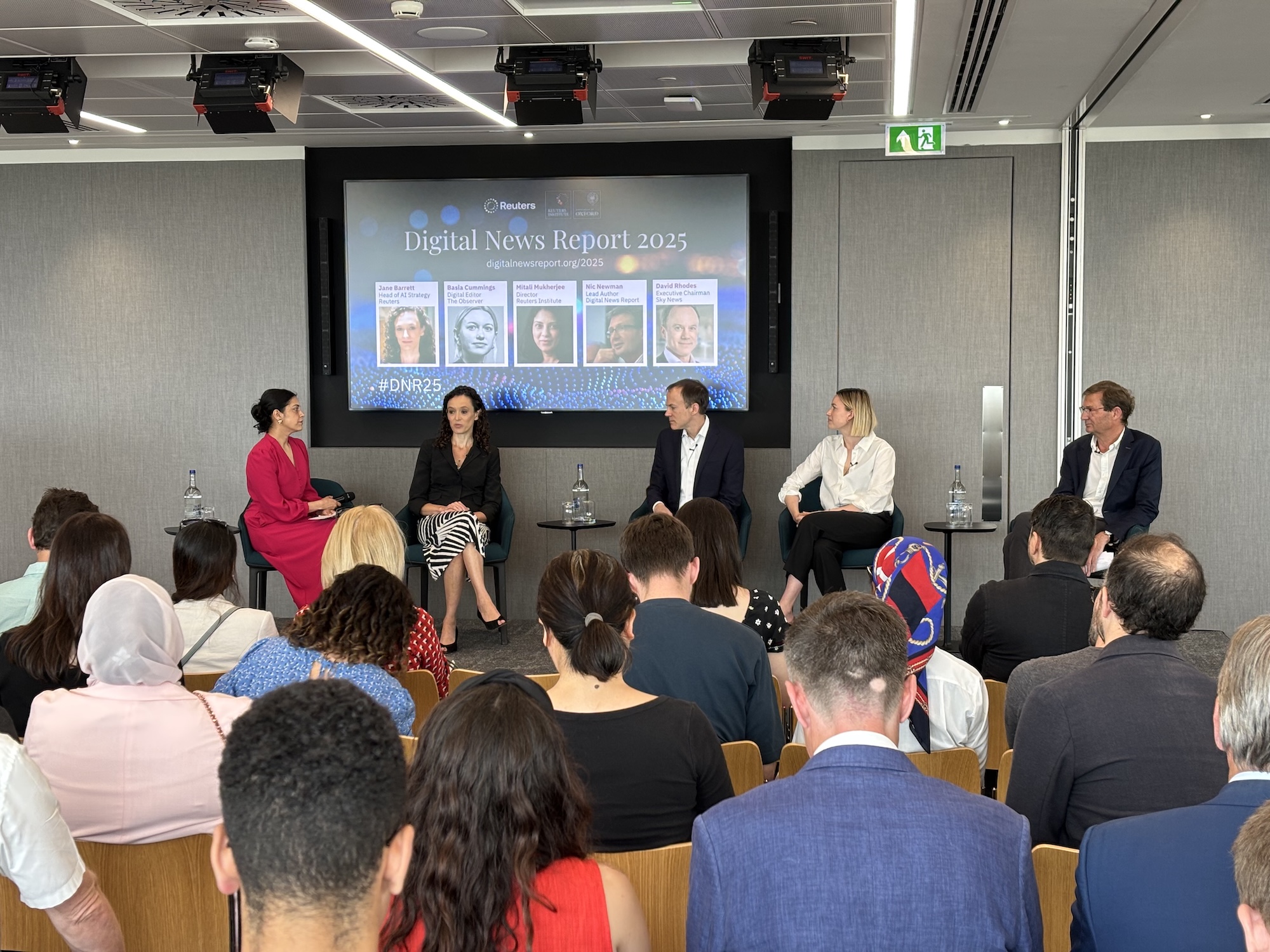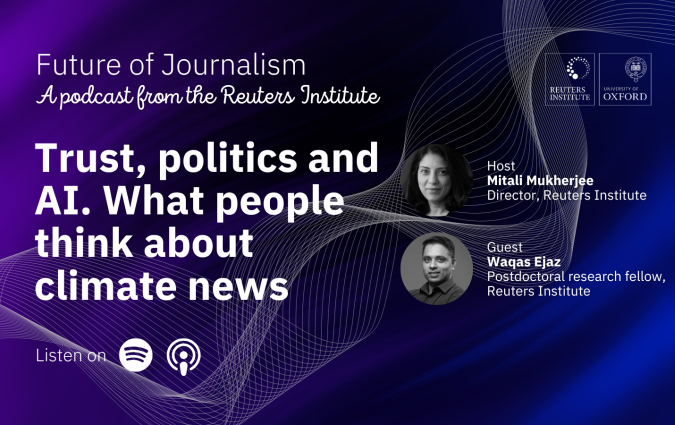“AI could lead to fewer and better told stories” – Our panel on navigating a fast-changing news ecosystem

Mitali Mukherjee, Jane Barrett, David Rhodes, Basia Cummings and Nic Newman during the event. | Credit: Eduardo Suárez
How can publishers maintain trust in an age when audiences are fragmented across so many different platforms and formats, including news podcasts and AI chatbots? Three prominent media managers reflected on this question and many others at the global launch events of our Digital News Report 2025.
More than 120 editors, researchers and media executives attended the event, which took place in London on Tuesday 17 June at Reuters HQ. It featured a presentation by lead author Nic Newman and a panel moderated by the Institute's director, Mitali Mukherjee, featuring David Rhodes, Executive Chairman of Sky News; Basia Cummings, Digital Editor of the Observer; and Jane Barrett, Head of AI Strategy at Reuters.
Watch the launch
A more fractured ecosystem
The report suggests that a series of platform shifts are shaping news consumption. The decline of legacy media across TV and print is well-documented. But the news industry is also now entering a more fractured media environment, where audiences consume news across different platforms and from an array of non-professional voices that includes podcasters and social media influencers as well.
“My own personal view is that publishers just need to be much more strategic about the way they use different platforms,” said Nic Newman on the panel. “Which audiences are you trying to meet in which countries? Which platforms are they on? What's in it for us? Are we looking for referrals? Are we looking for marketing to try and start to build a relationship?”
Our report found that news use across online platforms has steadily continued to fragment, with six online networks now reaching more than 10% of audiences with news content each week, compared with just two a decade ago. Around a third of our global sample use Facebook and YouTube (30%) for news each week. Instagram and WhatsApp are used by around a fifth, while TikTok (16%) remains ahead of X at 12%.
In this environment, our panellists agreed, it is more important than ever for news organisations to know their audiences and craft your offerings around their needs. Cummings said this is one of the most important things for her and her colleagues as they create the digital face of the Observer, recently bought by Tortoise Media.
“Although text does still dominate, looking at ecosystems rather than singular platforms is something we are factoring into our thinking,” she said. “We aren't going to be the kind of newsroom where people go to get their breaking headlines. There's no point in us trying to go for volume. What we can do is go through those formats for quality and through building relationships.”
Rhodes from Sky News said that the broadcaster has learned that formats and platforms are different, and audience expectations on each of these platforms are different too. Platform fragmentation has made the outlet rethink its audience engagement strategy.
“Legacy television based news organisations like ours used to make TV, and then have an industrial process to lift and shift elements of that to the constellation of social media platforms, but that doesn't work,” Rhodes said. “Where can we achieve the best commercial outcomes? Why don't we prioritise those and de-prioritise those that are just broad reach? We are not the only news organisation that is looking at engagement as a replacement for reach.”
An era of podcasts and news influencers
“People are looking for personalities and individuals, rather than brands, but they are still relying on brands for trust,” Cummings said.
She explained how Tortoise, the ‘slow news’ outlet that recently acquired the Observer, aimed to attract and engage young people in news and investigations through podcasts. In doing so, they found a young, majority-female audience for their investigative podcasts, which is unusual for the news industry,
The challenge now is to keep this audience engaged while reaching out to the Observer’s traditional print readership, which skews older and is predominantly male.
Cummings argued newsrooms should change the way they work to address some of the trends identified by the report. “One of the things that newsrooms have been less good at is collaboration and being distributed across platforms,” she said. “That’s now shifting. Organisations are less monolithic and an assembly of many parts that brings people in differently.”
Rhodes warned against over-tailoring a news product for a particular demographic. “It’s easier, it's a little purer, but it also potentially delivers more commercially if what we are doing is trying to identify addressable audiences for particular kinds of journalism, and then super-serve those,” he said. To Rhodes, this is preferable both commercially and editorially.
Rhodes expects podcasts to be increasingly consumed by video, pointing to one of the key trends in this year’s Digital News Report, which goes even further in markets like India and the US.
The continuing rise of AI
This year’s report found that only 7% of our global sample use AI chatbots and interfaces for news. But this percentage is much higher with under-25s, 15% of whom say they use AI to access news every week.
In this context, Jane Barrett explained that Thomson Reuters, Reuters’ parent company, is investing $200 million a year in AI, a figure that covers all Thomson Reuters businesses, not just news.
Reuters’ AI adoption goal has recently been raised from 50% to 100% of employees using AI at least 20 times a month, Barrett said. The agency is rolling out some AI functions on its app and news website such as text-to-speech and summarisation options, but is doing so quite cautiously to preserve accuracy and trust in its reporting, Barrett said.
Levels of comfort with AI vary regionally, Newman said, leading to regional differences in terms of innovation as well. As an example, he explained there are many more AI avatars in East Asia than elsewhere.
There are reasons to be optimistic about AI’s impact on journalism, Rhodes said. “It could lead to fewer stories told better, and more context, identifying audiences that are willing to pay for quality journalism. Those are not necessarily bad outcomes, and we really want to put some shoulder behind them.”
Barrett is also optimistic about what’s in store for journalism in an AI-mediated world: “The key thing for most traditional journalists is to have an open and learning mindset, to be looking out at things to see what’s happening out there and to think of how you fit in.”
When it comes to AI’s impact on entry-level journalists, she voiced some concern, but also added that those individuals are often the ones that experiment with AI the most, and see themselves working with it in the future.
The fight to restore trust
While overall trust in news has remained stable at 40% globally, news avoidance is higher than ever. Across markets, four in ten (40%) say they sometimes or often avoid the news, up from 29% in 2017.
Rhodes said that news audiences now trust individuals rather than institutions: “When we got into the business, trust was largely held by big institutional brands and conferred by those brands onto the individuals presenting the news, and that has flipped 180 degrees. Trust is now largely given or lent to individual reporters, and they can confer that on us as an institutional brand.”
According to our respondents, the best way for news organisations to increase trust would be to increase accuracy, transparency, and original journalism, while reducing what many see as biased coverage.
Barrett said that it is important to show your audiences that there is a path towards truth, particularly as AI muddles the waters with regard to identifying which images and videos are true or not. She recalled an experiment Reuters carried out last week on TikTok where video journalists took audiences on that platform behind the scenes to show them how they do their work. “This can help to build trust,” she said.
But does showing your work increase trust? Newman said that his research suggested that those sorts of initiatives work well with people who already trust a particular news brand, but they are less likely to persuade people who don’t trust the news.
“It’s reinforcing [trust] for people who already like the news or already think quality journalism is under threat,” he said. “For other people, probably less so.”
In every email we send you'll find original reporting, evidence-based insights, online seminars and readings curated from 100s of sources - all in 5 minutes.
- Twice a week
- More than 20,000 people receive it
- Unsubscribe any time
signup block
In every email we send you'll find original reporting, evidence-based insights, online seminars and readings curated from 100s of sources - all in 5 minutes.
- Twice a week
- More than 20,000 people receive it
- Unsubscribe any time





